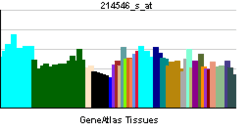P2RY11
| View/Edit Human | |||
P2Y purinoceptor 11 is a protein that in humans is encoded by the P2RY11 gene.[3][4]
The product of this gene, P2Y11, belongs to the family of G-protein coupled receptors. This family has several receptor subtypes with different pharmacological selectivity, which overlaps in some cases, for various adenosine and uridine nucleotides. This receptor is coupled to the stimulation of the phosphoinositide and adenylyl cyclase pathways and behaves as a selective purinoceptor. Naturally occurring read-through transcripts, resulting from intergenic splicing between this gene and an immediately upstream gene (PPAN, encoding peter pan homolog), have been found. The PPAN-P2RY11 read-through mRNA is ubiquitously expressed and encodes a fusion protein that shares identity with each individual gene product.[4]
See also
References
- ↑ "Drugs that physically interact with P2Y purinoceptor 11 view/edit references on wikidata".
- ↑ "Human PubMed Reference:".
- ↑ Communi D, Govaerts C, Parmentier M, Boeynaems JM (Jan 1998). "Cloning of a human purinergic P2Y receptor coupled to phospholipase C and adenylyl cyclase". J Biol Chem. 272 (51): 31969–73. doi:10.1074/jbc.272.51.31969. PMID 9405388.
- 1 2 "Entrez Gene: P2RY11 purinergic receptor P2Y, G-protein coupled, 11".
External links
- "P2Y Receptors: P2Y11". IUPHAR Database of Receptors and Ion Channels. International Union of Basic and Clinical Pharmacology.
Further reading
- van der Weyden L, Conigrave AD, Morris MB (2000). "Signal transduction and white cell maturation via extracellular ATP and the P2Y11 receptor". Immunol. Cell Biol. 78 (4): 369–74. doi:10.1046/j.1440-1711.2000.00918.x. PMID 10947861.
- Adams MD, Kerlavage AR, Fleischmann RD, et al. (1995). "Initial assessment of human gene diversity and expression patterns based upon 83 million nucleotides of cDNA sequence" (PDF). Nature. 377 (6547 Suppl): 3–174. PMID 7566098.
- Communi D, Suarez-Huerta N, Dussossoy D, et al. (2001). "Cotranscription and intergenic splicing of human P2Y11 and SSF1 genes". J. Biol. Chem. 276 (19): 16561–6. doi:10.1074/jbc.M009609200. PMID 11278528.
- Moore DJ, Chambers JK, Wahlin JP, et al. (2001). "Expression pattern of human P2Y receptor subtypes: a quantitative reverse transcription-polymerase chain reaction study". Biochim. Biophys. Acta. 1521 (1–3): 107–19. doi:10.1016/S0167-4781(01)00291-3. PMID 11690642.
- Duhant X, Schandené L, Bruyns C, et al. (2002). "Extracellular adenine nucleotides inhibit the activation of human CD4+ T lymphocytes". J. Immunol. 169 (1): 15–21. doi:10.4049/jimmunol.169.1.15. PMID 12077223.
- Strausberg RL, Feingold EA, Grouse LH, et al. (2003). "Generation and initial analysis of more than 15,000 full-length human and mouse cDNA sequences". Proc. Natl. Acad. Sci. U.S.A. 99 (26): 16899–903. doi:10.1073/pnas.242603899. PMC 139241
 . PMID 12477932.
. PMID 12477932. - Gerhard DS, Wagner L, Feingold EA, et al. (2004). "The Status, Quality, and Expansion of the NIH Full-Length cDNA Project: The Mammalian Gene Collection (MGC)". Genome Res. 14 (10B): 2121–7. doi:10.1101/gr.2596504. PMC 528928
 . PMID 15489334.
. PMID 15489334. - Moreschi I, Bruzzone S, Nicholas RA, et al. (2006). "Extracellular NAD+ is an agonist of the human P2Y11 purinergic receptor in human granulocytes". J. Biol. Chem. 281 (42): 31419–29. doi:10.1074/jbc.M606625200. PMID 16926152.
- Zylberg J, Ecke D, Fischer B, Reiser G (2007). "Structure and ligand-binding site characteristics of the human P2Y11 nucleotide receptor deduced from computational modelling and mutational analysis". Biochem. J. 405 (2): 277–86. doi:10.1042/BJ20061728. PMC 1904521
 . PMID 17338680.
. PMID 17338680.
This article incorporates text from the United States National Library of Medicine, which is in the public domain.
